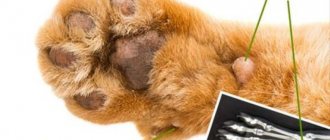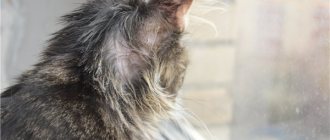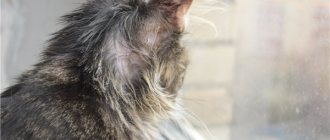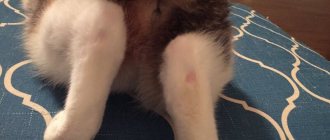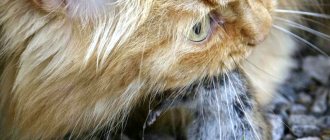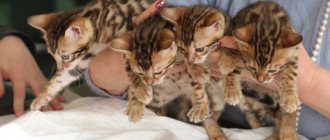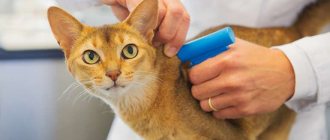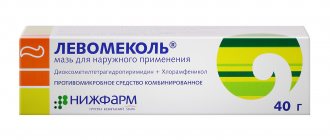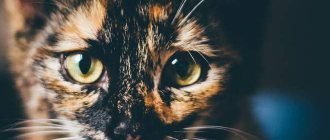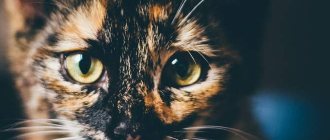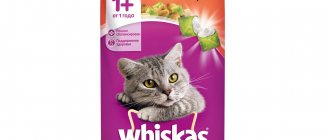Lameness due to injury
By injuries we do not necessarily mean sprains, fractures or dislocations. It could be a simple wound on the pad of the paw. Pain causes the cat to spare its paw.
If there are no visible injuries, check the cat's reaction by feeling its entire paw: carefully and gently, but with pressure. Perhaps it is a matter of deep trauma. If your cat reacts painfully to touch in a particular place, you should go to the veterinarian. He will take an x-ray to find out the cause. Moreover, sometimes wounds are observed not because of splinters, insect bites and injuries, but because of the disease described below. This disease is dangerous, and therefore an accurate diagnosis must be made as early as possible.
Diseases of the joints and bones
Diseases that affect a cat's joints are often age-related and occur after 6-8 years of life. Some pathologies are congenital and develop gradually; more than a month may pass before the first symptoms appear. Viral diseases and various infections often serve as the impetus for the development of inflammation of joint tissues. If a cat has lameness, the following diseases are possible:
- 1. Hip dysplasia. A genetic abnormality that an animal suffers from birth or has a predisposition to develop. It progresses even at a young age. Lameness in an animal is most noticeable after sleep or rest. When a pet “develops” its limbs after a long period of rest, the symptom is not very pronounced or becomes almost invisible.
- 2. Arthritis and arthrosis. These diseases in most cases occur in older cats and are the most common pathologies affecting the joints. Changes in tissues in both diseases are largely similar, as are the symptoms of their manifestation. The animal tries to move as little as possible - this way the pain practically goes away. The cat refuses to eat and becomes weaker, and sometimes there is a rise in body temperature. Swelling occurs in the joint area, the animal reacts aggressively to palpation, and a local increase in body temperature is felt.
- 3. Patella or luxation of the kneecap. The pathology is rare and is caused by genetic abnormalities or severe trauma. The disease manifests itself abruptly: the animal suddenly begins to limp, it experiences severe pain, to which the cat reacts by meowing and hissing. Treatment is required as soon as possible, since with further development of the disease, surgical intervention will become necessary.
- 4. Osteomyelitis. The disease most often occurs in cats at a young age during the period of active growth. It is characterized by the process of degeneration of bone tissue and its partial destruction, affecting both one limb and several at once. The disease causes severe pain, so the pet does not allow the affected paws to be touched.
- 5. Osteochondrosis. A disease of the spine, as a result of which the spinal roots are pinched or pinched, causing the cat to lame in various limbs. A failure in the formation of cartilage tissue leads to the abrasion of the cartilage layer between the vertebrae, which causes severe pain when moving. A cat sometimes not only limps on its hind leg, but also pulls it back.
- 6. Osteosarcoma. A malignant formation that occurs in bone tissue. Most often it affects animals over the age of 6 years.
All these diseases are serious and require timely treatment under the supervision of a specialist. Typically therapy consists of painkillers and corticosteroids. In severe cases, surgery is required. If you suspect that your cat is limping due to any of the listed joint diseases, you should immediately contact a veterinary clinic. At home, you can only waste time without proper treatment.
Lameness due to osteochondrodysplasia
In the case of lameness of a Scottish fold cat, the possibility of osteochondrodysplasia cannot be excluded. This disease is associated with changes in the structure of the musculoskeletal system and affects fold-eared cats. Read more about this disease in another article. Here we will say that the disease is incurable and can significantly ruin the pet’s quality of life, so a symptom such as lameness cannot be ignored. You need to go to the vet and get a diagnosis. The sooner therapy begins, the greater the chances for a fulfilling lifestyle.
ethnoscience
Using traditional medicine recipes, you can stop the development of the disease, but it will not be possible to completely cure your pet. Typically, traditional medicine is used during the first stage of the disease; to achieve positive results, treatment must be long and continuous. We offer several options for anti-growth recipes that can easily be prepared at home:
- Pour 100 g of unripe walnut fruits with hot vegetable oil, then infuse the resulting mixture for 24 hours. Then gently lubricate the problem area. Repeat this procedure for two weeks.
- Grind the bay and juniper leaves (6 pieces each). Then add a piece of butter (20 g), 15 drops of lavender or fir oil. Mix everything thoroughly.
- Secure a piece of propolis to the damaged surface with a bandage. The procedure must be repeated at least three times a week.
- Grind dry celandine leaves in a mortar and mix with rendered pork fat. The cream is applied to the painful area 3-4 times a week.
- Wipe the growths daily with any vegetable oil that is present in the house. The oil helps eliminate grooves from the surface of the skin horn.
- Cut a small aloe leaf, leave it in the refrigerator for 3 days, then apply the leaf to the affected area, securing it with an adhesive plaster.
- Rinse and dry 4 handfuls of onion peels. Then put them in a jar and fill them with 6% vinegar (1 cup). Infuse the infusion in a dark place for about 10 days. Then strain it and apply it to the tumor as a compress.
Now you know how to recognize cutaneous horn in a cat and how best to treat it. Try to take your pet to see a doctor at least twice a year. Don't neglect the health of your little friend.
This article has been checked and approved by a veterinarian. Knyazeva Anna Vladimirovna, veterinarian in private practice, Moscow. more about the expert.
Tags: cat health, cutaneous horn, cat
Treatment of lameness in cats
Treatment for lameness in cats depends on the cause. Depending on this, either only painkillers, or courses of antibiotics, or anti-inflammatory drugs, etc. will be prescribed. In some situations, complete healing is impossible, but the cat's condition can be maintained at the proper level. In any case, we recommend that you do not treat yourself, but go to a veterinary clinic. If your pet is given a bad diagnosis, you need to recheck it in another clinic, without initially saying that you already know the opinion of another doctor.
Rate and share!
Reasons why a cat is limping
There are many reasons why a cat does not step on its hind paw, as well as its front paw. Often the owner can immediately understand what happened, but there are also situations when an adult pet or kitten simply returns from a walk, limping heavily and mewing pitifully. In this case, the first thing to do is to carefully examine the paw, which the animal cannot stand on normally.
The following reasons may cause the problem:
:
- Stinging insect bite - the bites of wasps and bees are painful, and therefore, if a cat steps on an insect, he is guaranteed lameness for 2-4 days, even after the owner removes the bee sting or treats the wasp sting. The left or right limb may be affected. If the bite occurred 7-9 days ago and the cat is still limping, a visit to the veterinarian is required;
- Injury to the interarticular area - often occurs during a fight between cats if teeth are used; and also during active climbing on trees that have sharp thorns or twigs. If a cat is not careful, or gets too carried away with tracking birds, it can run into them. The injury most often affects the hind legs, since the animal usually still sees the place where the front paw is placed;
- Dislocation - occurs when unsuccessful jumps and falls cause unnatural movement of the head of the bone in the joint, causing it to come out of it. The paw completely loses mobility and hangs helplessly. Acute pain at the time of injury can cause the animal to go into shock. In this case, the cat may limp on its right or left hind leg. Even with treatment, the cat limps for a long time;
- A sprain is the most common limb injury in cats, in which a minor tear of part of the fibers of the ligaments occurs, causing pain and swelling in the paw. The cat limps quite heavily, but his general condition does not suffer. The animal remains cheerful and does not lose its appetite. Lameness usually goes away within a few days even without treatment. In case of severe sprain, to speed up the recovery of the ligaments, a course of therapy with the drug travmatin, which is administered in the form of injections, is indicated. The animal limps long and hard;
- A bruise is of a traumatic nature. If the injury is not severe, then the cat limps slightly and not for long. With a severe bruise, the cat falls seriously on its back paw, which looks swollen. The pet is limping in such a way that it cannot be ignored. If you move the fur apart, a pronounced hematoma will be clearly visible;
- A fracture is the most severe injury in which the integrity of the bone is disrupted. The cat is not only limping, but almost unable to stand on his paw. Occurs when a strong blow or paw is pinched. In rare cases, physiological fractures are possible, which occur due to the fact that the bones lose their natural strength. Such fractures occur even with minor impact on the bone. The cat is limping and cannot stand on its paw;
- Spinal injury in the lumbar region - with such damage, a disturbance in the transmission of nerve impulses occurs, due to which the movement of the hind legs is difficult and limited. In severe cases, complete paralysis of the hind limbs occurs. In case of injury without paralysis, lameness is observed immediately on 2 hind legs and can be very specific;
- Arthritis or arthrosis of the hip joint - the disease can be unilateral or bilateral. The animal limps in front of him, also wobbling its pelvis. It occurs most often in older cats, but can also affect young animals if they have suffered serious trauma to the pelvic area. With this phenomenon, lameness increases gradually, worsening the cat’s quality of life. Treatment is aimed primarily at slowing the progression of the pathological process. A complete cure is impossible.
The owner will not always be able to pinpoint the exact reason that caused the lameness, and therefore a consultation with a veterinarian may be required.
What is OHD
Translated from Greek, “osteo” means bone, and “dysplasia” means a developmental disorder. OCD is a genetic malformation of cartilage and bone tissue, leading to a slowdown in their growth. The result of this pathology is underdevelopment of the osteochondral system, including the ear cartilage (which is why cats of this breed have “falling” ears). Systemic skeletal lesions are most often expressed by deformation of the limbs. This disease often does not pose a direct threat to the animal’s life, but can significantly reduce its quality and duration.
Important! The purebred Scottish Fold and Highland Fold breeds are at risk for this disease. Both of them have a “defective” gene in their pedigree
If one of the cat’s parents was a Scottish Straight (Scottish Straight or Highland Straight), he will inherit one mutated gene, and the animal’s chances of developing osteochondrodysplasia will be halved.
How to increase the lifespan of a Scotsman
Thanks to many advances in veterinary medicine and the development of the pet business, the lives of pets have become much longer and more comfortable. To ensure that 15 years is not the limit for the life expectancy of a Scottish Fold, its owner must be responsible, starting with the choice of a kitten and throughout the pet’s life.
You should only purchase a fold-eared baby from a conscientious, reputable breeder or at a cat show.
This solution minimizes the risk of purchasing a sick animal. Particular attention should be paid to issues of maintenance and care. Even before the furry newcomer appears in the house, you need to decide on the type of food he will eat, whether it will be factory-made food or natural products. When choosing ready-made food, preference is usually given to the “super-premium” and “holistic” classes: these lines take into account the age, breed and individual characteristics of cats. A natural diet should be balanced, varied, meeting the needs of carnivores in general and Scottish Folds in particular: contain not only all nutrients, but also taurine, which Scottish cats, like all other cats, do not produce on their own.
- Routine and preventive examinations by a veterinarian are required, as well as timely vaccinations against rabies, panleukopenia, chlamydia, calcevirosis, and rhinotracheitis.
- Given the propensity of the Scottish population for cardiomyopathy and the difficulty in diagnosing this disease, ultrasound of the heart and chest should be included in the examination.
- Monitoring the condition of the gums and teeth must be constant: dental problems lead to diseases of the digestive system.
- If breeding a breed is not the purpose of purchasing an animal, it is advisable to sterilize it in due time.
- Regardless of whether the Scottish Fold is outdoors or in contact with other animals, periodic anti-parasitic measures are required.
- To maintain muscle tone and good shape, your pet needs to be provided with physical activity through games and training.
Such careful care and sincere love will allow the Scottish Fold to live to the respectable age of twenty.
Return to content
How is the diagnosis made?
An examination is sufficient for a preliminary diagnosis. If you have a fold-eared kitten (or an adult cat) and you observe the following symptoms, you may suspect OCD:
– began to limp for no particular reason.
– the gait has changed. Protects one or more limbs, hunches over.
– there is a delay in growth, a violation of proportions (short legs, tail...).
– you observe deformation of the joints, most often the hind limbs are affected.
– the tail loses mobility, becomes like a “stick”, and when trying to bend the animal experiences pain.
To clarify, an x-ray is taken. The image evaluates the density of bone tissue, whether there are anatomical changes in the joints, the presence of bone exostosis (growth) and other changes.
The doctor may also recommend additional tests: general blood test, blood biochemistry, ultrasound…. In order to exclude other diseases or identify disorders that often develop in parallel with osteochondrodysplasia.
For example, kidney disease, mineral metabolism disorders, etc.
ZooForum: Scottish Dog Lame on Front Leg – ZooForum
(others can give advice in a PM, indicating that the advice is not given by a veterinarian. But the forum is not responsible for THESE advice.)
Scottish Dog Lame on Front Leg after Moving
Good afternoon Scottish Fold cat, 1 year old, weight 3500, eats natural food (porridge with meat, cottage cheese, sour cream), I give a breeder for fur, in general there are no deviations, cheerful and active. Yesterday we were transported by train overnight, it was not bad, I slept. He was released this morning and is limping on his right front leg. She didn’t jump, didn’t hit, her paw doesn’t hurt, I felt everything, she doesn’t react, her claws are trimmed. Please tell me what is causing the lameness? Is it possible due to a long period of rest on the road? Thank you in advance!
Our parents are Scottish Fold and British Straight. For some reason I thought it was because of the move, since last time I was transported in the same way on a train, and I limped for several days, then it went away on its own. Here we go again. Unfortunately, X-rays are not possible at the moment. Excuse me, but why is the diet not balanced? I don’t give her everything at once, boil carrots and vegetables separately, for example (rarely), meat separately, sometimes with porridge, and milk. During the week, her diet is very varied. She is also very picky and “buries” almost all her food. He does not eat raw (frozen) meat. I don’t give anything from the table, nothing fried, fatty, salted, smoked. I always cook for her separately. Chicken breast, hearts, liver, lung, lean beef. Rarely fish.
You have a heavy breed, you need additional calcium, vitamins, preferably glucosamine-chondroitin in general. Lameness may be the first sign of chondrodysplasia, an incurable genetically determined fold disease. I would have gotten nervous if I read “British Straight” in the docks - there is no such breed.
We visit the vet regularly and unfortunately
Source
Low immunity
Newborn Scottish kittens have a critical period of life after birth. With mother's milk they receive antibodies, all the vitamins and microelements that allow the baby to strengthen the immune system. During this period, it is important for the owner to provide the mother cat with ready-made, premium, balanced nutrition, specially designed for nursing animals. Breeders do not advise stopping maternal feeding until the kitten is 3 months old. Before transferring a pet to a new family, mandatory vaccinations and protection against dangerous infections are carried out.
Timely vaccinations strengthen the immune system and save young pets from infection with dangerous viral diseases: calcivirosis, rhinotracheitis, panleukopenia, which can lead to death.
Attention! The owner is obliged to comply with the deadlines for all vaccinations, which increases immunity, preserves the pet’s health, and prolongs life.
Loose stools
Stool upset, or diarrhea, can be caused by various reasons:
- Poor nutrition. Sometimes a Scottish cat, being picky about its diet, may eat a product that is poorly accepted by the stomach, while the body’s reaction may result in short-lived, light-colored diarrhea.
- Food poisoning, stale food or chemical components of food or the environment, cause serious damage to the animal’s gastrointestinal tract with loose yellow-green stools and periodic vomiting.
- Intestinal parasites: worms, roundworms and tapeworms, Giardia, nematodes and other helminths, appear in the pet’s stomach, poison the body, and lead to diarrhea, which is periodic.
- Infectious diseases caused by viruses and bacteria lead to serious illnesses: panleukopenia, calcivirus infection, rotavirus enteritis, salmonellosis, a symptom that causes serious stool disorder.
Each disorder requires attention and assistance from the owner. If diarrhea persists, keep your pet hydrated and seek help from a veterinarian.
Vitamins
How and when to add vitamins and minerals to Scottish cats’ food depends on their diet:
- When feeding a pet with ready-made dry or wet premium or extra-class food, it is even harmful to give additional vitamin complexes. The manufacturer supplies its products in a balanced manner, providing all the necessary nutrients.
- With a homemade diet, be sure to add vitamins to kitten food. They grow rapidly and especially need enriched, healthy food. Vitamins useful for kittens:
- “A” (retinol), its deficiency affects vision;
- group “B”, their lack reduces appetite, lethargy and constipation appear, which lead to dysbacteriosis, shedding of hair;
- “D” is important for the formation of the animal’s skeleton, increases the flexibility of the limbs, the growth of strong teeth;
- “E”, participates in the formation of reproductive function, stabilizes the functioning of the liver kidneys;
- ascorbic acid, vitamin “C” strengthens the entire body and improves immunity.
By adding a vitamin complex to homemade food, the owner helps the pet grow into a strong and healthy kitten.
